Arethusa (mythology)
In Greek mythology, Arethusa (/ˌærɪˈθjuːzə/; Greek: Ἀρέθουσα) was a nymph and daughter of Nereus (making her a Nereid),[1] who fled from her home in Arcadia beneath the sea and came up as a fresh water fountain on the island of Ortygia in Syracuse, Sicily.
| Greek deities series |
|---|
| Nymphs |
Mythology
The myth of her transformation begins in Arcadia when she came across a clear stream and began bathing, not knowing it was the river god Alpheus, who flowed down from Arcadia through Elis to the sea. He fell in love during their encounter, but she fled after discovering his presence and intentions, as she wished to remain a chaste attendant of Artemis. After a long chase, she prayed to her goddess to ask for protection. Artemis hid her in a cloud, but Alpheus was persistent. She began to perspire profusely from fear, and soon transformed into a stream. Artemis then broke the ground allowing Arethusa another attempt to flee.[2] Her stream traveled under the sea to the island of Ortygia, but Alpheus flowed through the sea to reach her and mingle with her waters.[3] Virgil augurs for Arethusa a salt-free passage beneath the sea on the condition that, before departing, she grant him songs about troubled loves, not those in her own future, but those of Virgil's friend and contemporary, the poet Cornelius Gallus, whom Virgil imagines dying from unrequited love beneath the famous mountains of Arcadia, Maenalus and Lycaeus.[4]
During Demeter's search for her daughter Persephone, Arethusa entreated Demeter to discontinue her punishment of Sicily for her daughter's disappearance. She told the goddess that while traveling in her stream below the earth, she saw her daughter looking sad as the queen of Hades.[5]
The Roman writer Ovid called Arethusa by the name "Alpheias", because her stream was believed to have a subterranean communication with the river Alpheius, in Peloponnesus.[6][7][8]
Apart from retellings by classical authors including Ovid and Virgil, Percy Bysshe Shelley wrote a poem on Arethusa in 1820.
Coin of Arethusa
As a patron figure of Syracuse, the head of Arethusa surrounded by dolphins was a usual type on their coins.[9] They are regarded as among the most famous and beautiful Ancient Greek coins.[10]
In music
Karol Szymanowski, polish classical music composer named "The Fountain of Arethusa" first of his three poems entitled "Myths" for violin and piano. The Saucy Arethusa is an 18th-century song about a British naval ship named after Arethusa. A song on the album Her Majesty the Decemberists by The Decemberists called "Shanty for the Arethusa" is about a different ship called Arethusa. A movement of Benjamin Britten's oboe piece Six Metamorphoses After Ovid is entitled "Arethusa."
Also Ralph Vaughan Williams, the English classical music composer, composed "Sea Songs", a quick march for both brass band and wind band written in 1923, used a Morris Dance tune 'The Royal Princess' which was also known by the title 'The Arethusa', alongside two other shanty tunes 'Admiral Benbow' and 'Portsmouth'.
Gallery
Arethusa and Alpheus
 Aréthuse by Auguste François Jean Baptiste Legras (Salon 1874)
Aréthuse by Auguste François Jean Baptiste Legras (Salon 1874) Arethusa by Philip Galle (1587)
Arethusa by Philip Galle (1587)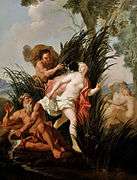 Alpheus chasing Arethusa by Antoine Coypel (18th-century)
Alpheus chasing Arethusa by Antoine Coypel (18th-century) Alpheus and Arethusa by René-Antoine Houasse
Alpheus and Arethusa by René-Antoine Houasse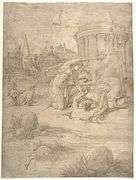 The Story of Arethusa by Francesco Primaticcio
The Story of Arethusa by Francesco Primaticcio- Scultore fiorentino, alfeo e aretusa, 1561-62
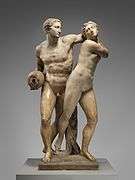 Alpheus and Arethusa by Battista di Domenico Lorenzi (1568–70)
Alpheus and Arethusa by Battista di Domenico Lorenzi (1568–70)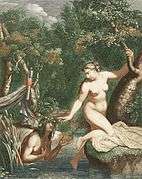 Alpheus and Arethusa by Abraham Bloteling (between 1655 and 1690)
Alpheus and Arethusa by Abraham Bloteling (between 1655 and 1690)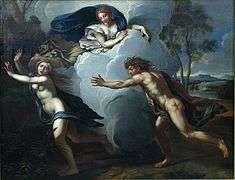 Alpheus and Arethusa (Roman School, circa 1640)
Alpheus and Arethusa (Roman School, circa 1640)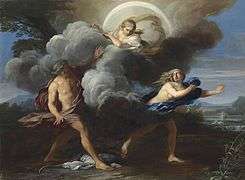 Alpheus and Arethusa by Carlo Maratta (7th-century)
Alpheus and Arethusa by Carlo Maratta (7th-century)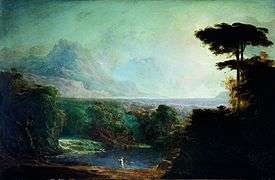 Alpheus and Arethusa by John Martin (1832)
Alpheus and Arethusa by John Martin (1832) Aretusa by Antonio Triva (17th century)
Aretusa by Antonio Triva (17th century) Arethusa Chased by Alpheus by Wilhelm Janson and Antonio Tempesta (1606)
Arethusa Chased by Alpheus by Wilhelm Janson and Antonio Tempesta (1606)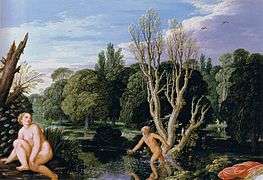 Alpheus and Arethusa by Johann König (probably 1610s)
Alpheus and Arethusa by Johann König (probably 1610s)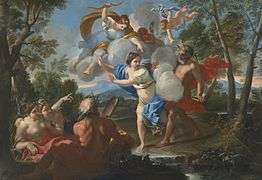 Alpheus and Arethusa by Luigi Garzi
Alpheus and Arethusa by Luigi Garzi- La Ninfa Aretusa by Alexandre Crauk
 Alpheus and Arethusa by Paolo de Matteis (1710)
Alpheus and Arethusa by Paolo de Matteis (1710) Alpheus and en:Arethusa by Bernard Picart
Alpheus and en:Arethusa by Bernard Picart- Aréthuse et Alphée by Léopold Burthe (1847)
- Arethusa
Arethusa and Demeter
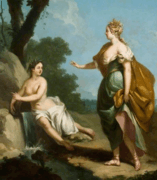 Arethusa Tells Ceres of Proserpine's Fate (1685–1775)
Arethusa Tells Ceres of Proserpine's Fate (1685–1775)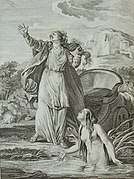 Ceres and Arethusa, engraving by Vincenz Grüner (1791)
Ceres and Arethusa, engraving by Vincenz Grüner (1791) Demetra e Aretusa (1751–1801)
Demetra e Aretusa (1751–1801) Ceres and Arethusa, engraving by Ludovico Dolce (1558)
Ceres and Arethusa, engraving by Ludovico Dolce (1558)
See Also
References
- ↑ Virgil, Georgics 4.344
- ↑ Ovid, Metamorphoses 5.710
- ↑ Pausanias, Description of Greece 5.7.3
- ↑ Virgil, Bucolics 10.1–15 Virgil; John Van Sickle (2011). Virgil's Book of Bucolics. The Ten Eclogues Translated into English Verse Framed by Cues for Reading Aloud and Clues for Threading Texts and Themes. Baltimore: Johns Hopkins University Press. pp. 109–112. ISBN 0-8018-9799-8.
- ↑ Ovid, Metamorphoses 5.407
- ↑ Ovid, Metamorphoses 5. 487
- ↑ Schmitz, Leonhard (1867). "Alpheias". In William Smith. Dictionary of Greek and Roman Biography and Mythology. 1. Boston: Little, Brown and Company. p. 133. Archived from the original on 2008-06-13.
- ↑ Ovid (1997). William S. Anderson, ed. Metamorphoses. Norman, Oklahoma: University of Oklahoma Press. p. 548. ISBN 0-8061-2894-1.
- ↑ Coins of Arethusa (contains verse from Ovid and Shelley); [http://www.pcgs.com/News/Changes-In-The-Depiction-Of-Arethusa-On-The-Coins-Of "Changes in the Depiction of Arethusa on the Coins of Syracuse", PCGS
- ↑ Paul Fraser Coins, "In his definitive 1990 book "Ancient Greek Coins", the numismatist G. K. Jenkins describes Syracusan decadrachms of this period as "perhaps the most famous of all ancient coins"."
External links
| Wikimedia Commons has media related to Arethusa (mythology). |
| Look up Arethusa in Wiktionary, the free dictionary. |

- Warburg Institute Iconographic Database (ca 40 images of Arethusa)